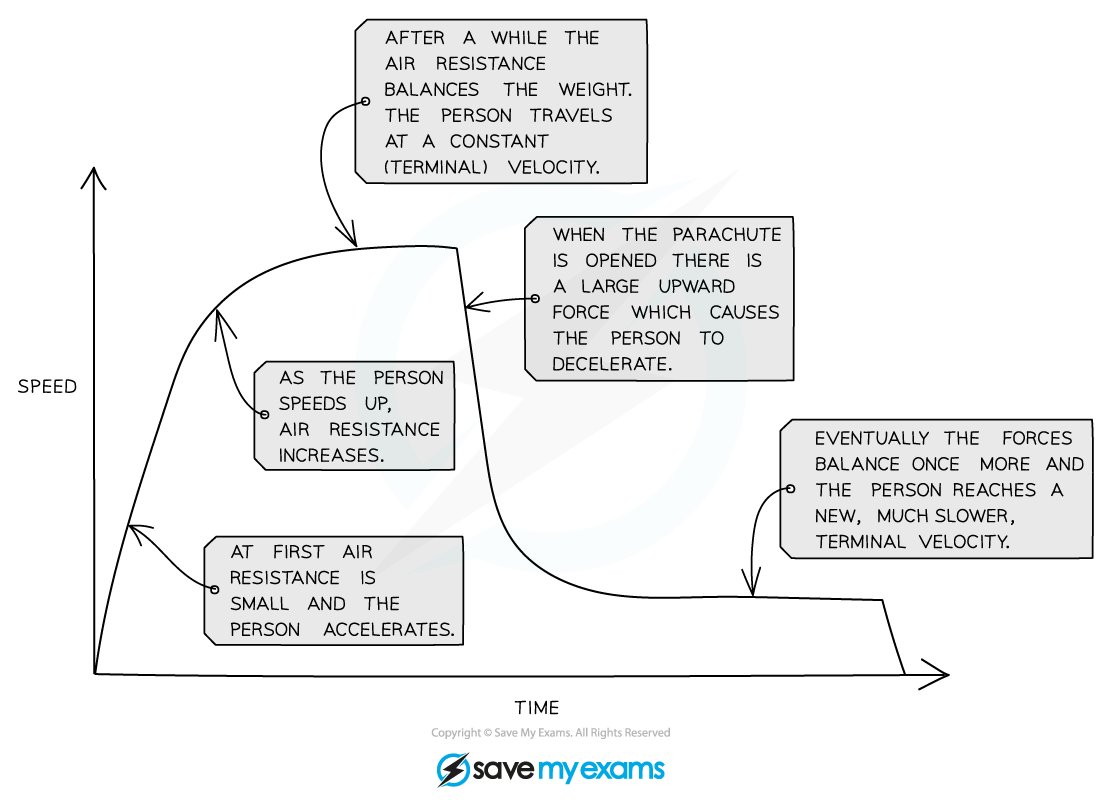Terminal Velocity (OCR A Level Physics): Revision Note
Exam code: H556
Terminal Velocity
For a body in free fall, the only force acting is its weight and its acceleration g is only due to gravity.
The drag force increases as the body accelerates
This increase in velocity means the drag force also increases
Due to Newton’s Second Law, this means the resultant force and therefore acceleration decreases (recall F = ma)
When the drag force is equal to the gravitational pull on the body, the body will no longer accelerate and will fall at a constant velocity
This velocity is called the terminal velocity



A skydiver in freefall reaching terminal velocity
The graph shows how the velocity of the skydiver varies with time
Since the acceleration is equal to the gradient of a velocity-time graph, the acceleration decreases and eventually becomes zero when terminal velocity is reached
After the skydiver deploys their parachute, they decelerate to a lower terminal velocity to reduce the impact on landing
This is demonstrated by the graph below:

A graph showing the changes in speed of the skydiver throughout their entire journey in freefall
Worked Example
Skydivers jump out of a plane at intervals of a few seconds.
Skydivers A and B want to join up as they fall.

If A is heavier than B, who should jump first?
Answer:
Skydiver B should jump first since he will take less time to reach terminal velocity
His terminal velocity will also be a lower speed than that of skydiver A
This is because skydiver A has a higher mass, and hence, weight
A greater weight means a greater acceleration for A than B at every stage until terminal velocity
Air resistance gets larger with speed, so for air resistance to match A's weight, A must be travelling faster than B at terminal velocity
This means if A were to jump first, skydiver B would never catch up
Skydiver B must jump first, then skydiver A can catch up
Worked Example
The diagram below shows the graph of velocity v against time t for the ball as it travels through the oil. The ball enters the oil at time t = 0.

In terms of the forces acting on the ball, describe and explain its motion at
a) Point A
b) Point B
Answer:
Part (a)
At A:
The drag force is greater than the weight of the ball
Therefore, the ball is decelerating
Part (b)
At B:
The drag force is equal to the weight
The ball has reached terminal velocity and is no longer decelerating
Examiner Tips and Tricks
Exam questions about terminal velocity commonly involve the motion of skydivers as they fall
A common misconception is that skydivers move upwards when their parachutes are deployed - however, this is not the case, they are in fact decelerating to a lower terminal velocity

You've read 0 of your 5 free revision notes this week
Unlock more, it's free!
Did this page help you?